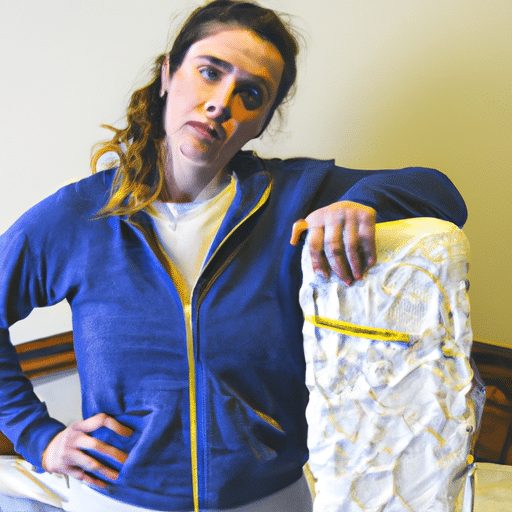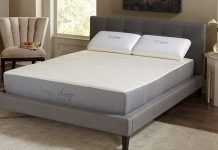Have you ever wondered if it’s possible to fix a sagging mattress? Well, we’re here to tell you that it is indeed possible! A sagging mattress can prevent you from enjoying a good night’s sleep, but fret not because there are solutions out there that can help restore it to its original firmness. In this article, we’ll explore some tips and tricks on how to repair a sagging mattress, so you can wake up feeling refreshed and rejuvenated each morning. Say goodbye to tossing and turning, and hello to a comfortable night’s sleep!
Review contents
Causes of a Sagging Mattress
Worn Out Springs
One common cause of a sagging mattress is worn-out springs. Over time, the metal coils in the mattress can lose their elasticity and start to sag, resulting in a lack of support. This often happens with older mattresses or those of lower quality. When the springs no longer provide the necessary support, the mattress can sag and create discomfort.
Deteriorated Foam or Padding
Another cause of a sagging mattress is deteriorated foam or padding. The foam and padding layers in a mattress are designed to provide cushioning and support. However, over time, these materials can break down and lose their ability to bounce back. This can result in sagging areas in the mattress, especially in places where you typically sleep. The loss of padding and foam can cause uneven support and discomfort.
Excessive Weight or Overuse
Excessive weight or overuse can also contribute to a sagging mattress. When a mattress is continuously subjected to heavy loads, such as when multiple people sleep on it or when it is used for activities other than sleeping, it can put strain on the materials and structure of the mattress. This constant pressure can cause the mattress to sag and lose its shape over time.
Improper Maintenance
Improper maintenance can also lead to a sagging mattress. Without proper care, a mattress can become susceptible to sagging. For example, failing to rotate or flip the mattress regularly can result in uneven wear and sagging. Furthermore, neglecting to clean and protect the mattress can lead to the deterioration of its components, causing sagging to occur.
Signs of a Sagging Mattress
Visible Indentations
One of the most noticeable signs of a sagging mattress is visible indentations. These indentations occur when the materials in the mattress start to break down or lose their shape, resulting in depressions or dents. You may be able to see these indentations when looking at the mattress, and they can often coincide with the areas where you typically sleep.
Sinking Feeling
Another sign of a sagging mattress is a sinking feeling when lying down. Instead of feeling supported and properly aligned, you may feel like you are sinking into the mattress. This sinking sensation can be uncomfortable and can also contribute to poor sleep quality. If you find yourself constantly readjusting your position to alleviate this sinking feeling, it may be a sign that your mattress is sagging.
Uneven Surface
An uneven surface is also a common sign of a sagging mattress. When a mattress sags, it often loses its flat and even surface. Instead, you may notice lumps, bumps, or areas that are higher or lower than others. This uneven surface can make it challenging to find a comfortable position and can result in discomfort and disturbed sleep.
Potential Health Issues
Back, Neck, and Hip Pain
Sleeping on a sagging mattress can lead to various health issues, including back, neck, and hip pain. When a mattress sags, it fails to provide adequate support to the body, causing improper spinal alignment and adding pressure to certain areas. This can result in pain and stiffness in these crucial areas, making it difficult to sleep comfortably and wake up refreshed.
Muscle Aches and Stiffness
In addition to specific pain in the back, neck, and hips, a sagging mattress can contribute to overall muscle aches and stiffness. When the body is not properly supported during sleep, it can lead to muscle strain and tension. This can manifest as generalized soreness and stiffness, making it harder to move and carry out daily activities with ease.
Sleep Disruptions and Insomnia
A sagging mattress can also disrupt your sleep and lead to insomnia. The discomfort and lack of support can make it challenging to find a comfortable and restful position. You may find yourself tossing and turning throughout the night, unable to find relief. This can result in a fragmented sleep pattern, leaving you feeling tired and groggy during the day.
Repair vs. Replacement
Assessing the Extent of the Sag
Before deciding whether to repair or replace a sagging mattress, it is essential to assess the extent of the sag. If the sag is minimal and does not significantly impact your comfort and support, you may be able to address the issue through repair methods. However, if the sag is severe and affects the overall structural integrity of the mattress, it may be more cost-effective and practical to replace it.
Consideration of Mattress Age
The age of the mattress is also a crucial factor to consider when deciding between repair and replacement. If your mattress is relatively new and still within its expected lifespan, it may be worth exploring repair options. However, if the mattress is already several years old and showing signs of wear and tear in addition to the sagging, it may be time to invest in a new mattress instead.
Cost-Comparison
When considering whether to repair or replace a sagging mattress, it is essential to compare the costs. On one hand, repairing a mattress through DIY methods or professional services can be significantly cheaper than buying a new one. However, if the mattress is beyond repair and would require extensive repairs or reinforcement, it might be more cost-effective to replace it with a new mattress that offers better support and longevity.
DIY Methods to Fix a Sagging Mattress
Mattress Flipping or Rotation
One simple DIY method to fix a sagging mattress is to flip or rotate it regularly. This can help distribute the weight and pressure evenly across the mattress, minimizing sagging in specific areas. Flipping the mattress over can be especially effective if the sag is only present on one side. However, not all mattresses are designed to be flipped, so check the manufacturer’s instructions before attempting this method.
Placing Plywood Underneath
Another DIY method is to place plywood boards underneath the mattress. This can provide additional support and help prevent further sagging. Simply cut plywood boards to fit the size of your mattress and place them evenly across the bed frame. The plywood acts as a sturdy foundation, reducing the strain on the mattress and promoting a flatter sleeping surface.
Adding a Mattress Topper
A mattress topper can also be an effective DIY solution for a sagging mattress. Toppers come in various thicknesses and materials, and they can provide an extra layer of cushioning and support. Look for a topper that matches your desired level of firmness and support. By placing the topper on top of the sagging areas, you can help alleviate discomfort and improve the overall feel of the mattress.
Professional Repair and Reinforcement Options
Consulting with Mattress Manufacturer
If your mattress is still within its warranty period, it is advisable to consult with the mattress manufacturer before attempting any repairs or reinforcements. They may offer specific advice or guidelines on how to address the sagging issue. They might even provide repair or replacement services if the sagging is due to manufacturing defects. Contacting the manufacturer can provide valuable insights and potentially save you money.
Engaging a Professional Mattress Repair Service
For more complex or severe sagging issues, it may be necessary to engage a professional mattress repair service. These professionals have the expertise and tools to assess, repair, and reinforce your mattress effectively. They can identify the root cause of the sagging and implement appropriate repairs, such as replacing worn-out springs or adding supportive materials. While this option may come with a cost, it can often revive your mattress and extend its lifespan.
Mattress Reinforcement Products
There are also various mattress reinforcement products available in the market that can help fix a sagging mattress. These products are specifically designed to provide additional support and stability to a worn-out mattress. From adjustable firmer support systems to under-mattress slats and inserts, these products can help redistribute weight and alleviate sagging. Consider researching and investing in a suitable reinforcement product that matches your specific mattress and sagging issue.
When to Replace a Sagging Mattress
Severe Sag and Lack of Support
If your mattress has a severe sag and lacks support, it may be time to replace it. A mattress that is significantly sagging can no longer provide proper body alignment and support, leading to discomfort and potential health issues. Sleeping on a severely sagging mattress can exacerbate existing pain and strains, making it harder to get a good night’s sleep.
Visible Wear and Tear
If your mattress shows significant visible wear and tear in addition to sagging, it is a good indication that it needs replacement. Worn-out materials, holes, or tears in the fabric, and exposed springs are signs of a mattress that has reached the end of its lifespan. Continuing to sleep on such a mattress can compromise your comfort and safety.
Persistent Pain or Discomfort
If you experience persistent pain or discomfort while sleeping on your sagging mattress, it is time to consider a replacement. While some pain may be alleviated through temporary fixes or repairs, if the discomfort persists despite your efforts, it suggests that the mattress is no longer suitable for your needs. Investing in a new mattress that offers proper support and comfort can help improve your sleep quality and overall well-being.
Choosing a Suitable Replacement
Mattress Types and Materials
When choosing a suitable replacement for your sagging mattress, consider the different types and materials available. There are various options, such as memory foam, latex, innerspring, and hybrid mattresses. Each type offers unique characteristics in terms of support, comfort, and durability. Research and test out different types to determine which one aligns best with your preferences and needs.
Firmness and Support Levels
The firmness and support levels of a mattress are crucial factors to consider when replacing a sagging mattress. The ideal firmness and support level depend on your personal preferences and specific sleep needs. While some prefer a firm mattress for extra support, others find a softer mattress more comfortable. It is important to find a balance that provides adequate support to your body while ensuring a comfortable sleeping surface.
Budget Considerations
Budget considerations are also important when replacing a sagging mattress. Mattresses come in a wide price range, varying based on the type, brand, and features. Set a budget that you are comfortable with and look for mattresses that fit within that range. Remember to consider the long-term investment value of a durable and high-quality mattress when making your decision.
Preventing Mattress Sagging
Regular Cleaning and Maintenance
Preventing mattress sagging begins with regular cleaning and maintenance. Keep your mattress clean by vacuuming it regularly to remove dust, dirt, and allergens. Additionally, consider using a mattress protector to minimize the chances of spills or stains. Follow the manufacturer’s care instructions and rotate or flip the mattress according to their recommendations. By practicing regular cleaning and maintenance, you can extend the lifespan of your mattress and prevent premature sagging.
Using a Mattress Protector
Using a mattress protector is an effective way to prevent sagging and protect your mattress from spills and stains. A waterproof and breathable mattress protector acts as a barrier between your body and the mattress, preventing sweat, oils, and other fluids from seeping into the mattress. This can help maintain the integrity of the materials and reduce the risk of sagging caused by moisture or contaminants.
Proper Handling and Care
Proper handling and care are essential to prevent mattress sagging. When moving or transporting your mattress, avoid bending or folding it excessively, as this can damage the internal structure. Instead, use appropriate lifting techniques and support the mattress evenly from its edges or corners. Avoid jumping or placing excessive weight on the mattress, as this can strain the materials and lead to sagging. By treating your mattress with care, you can prolong its lifespan and reduce the chances of sagging.
Conclusion
Sagging mattresses can be a source of discomfort, pain, and sleep disturbances. However, with the right knowledge and actions, it is often possible to address sagging issues effectively. By understanding the causes of a sagging mattress, recognizing the signs, and considering the potential health issues, you can make informed decisions on whether to repair or replace your mattress. DIY methods such as flipping or rotating, placing plywood, or adding a mattress topper can provide temporary relief. For more severe sagging, professional repair services and mattress reinforcement products are available options. However, if the sagging is severe, the mattress shows visible wear and tear, or you experience persistent pain or discomfort, it may be time to invest in a new mattress. When choosing a replacement, consider mattress types, materials, firmness, support levels, and your budget. Finally, adopt preventive measures such as regular cleaning and maintenance, using a mattress protector, and proper handling and care to extend the lifespan of your mattress and prevent sagging. By evaluating the severity of sagging, considering repair options, and implementing preventive measures, you can prolong the lifespan of your mattress and ensure a restful night’s sleep.































